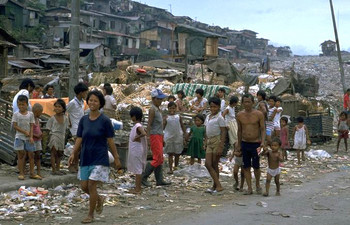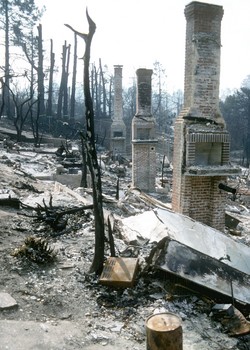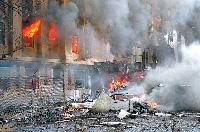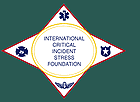
|
As hurricanes batter the coast, rivers flood, forest fires rage, tornadoes swirl, tsunami fears abound and terrorism thrives, www.psychceu.com is pleased to announce a new course:

|
|
Disaster Mental Health Services:
A
Primer for Practitioners |
This course meets the qualifications for 8 hours of continuing education
|
"Both authors bring an extraordinary wealth of experience to this volume, and it shows. The text is grounded in practical science, reasonable interpretations of theoretical and scientific perspectives, and then expands to practical, practitioner-oriented guidelines and recommendations. Simply said, this is without a doubt the best book currently available on the topic of disaster mental health. It should be mandatory reading for students as well as practitioners." George S. Everyly, Jr., Ph.D., author, A Clinical Guide to the Treatment of the Human Stress Response Please join us in this 8 unit course. |

|
Learning Objectives In this 8 unit course clinicians will:
|

| This course consists of a post-test based upon reading the text. There is no online material to read. After you pass the post-test, you may print out your own certificate. |
maintains responsibility for the program. |
|

Table of Contents Part 1: Disaster Concepts and Roles |
Psychological Recovery From Disaster: Key Concepts For Delivery Of Mental Health ServicesBy Diane Myers, R.N., M.S.N.NCP Clinical Quarterly 4(2): Spring 1994In recent years, disasters have ravaged communities and psyches across the United States. Major events have included Hurricane Hugo, the Loma Prieta Earthquake, the Oakland Hills Firestorm, Hurricanes Andrew and Iniki, the Midwest Floods of 1993, and the Northridge Earthquake in Los Angeles in January, 1994. Mental health professionals have been important members of the recovery teams assisting impacted communities and individuals. Research and experience consistently indicate that mental health services in disaster must differ significantly from traditional mental health programs in order to be effective. Clinical expertise and a sincere desire to help are not enough. The following are some key concepts that need to be considered in designing disaster mental health programs. No One Who Sees A Disaster is Untouched By ItIn addition to people directly affected, many other individuals are emotionally impacted simply by being in the disaster-stricken community. A disaster is an awesome event. Massive destruction and terrible sights evoke deep feelings (1). A disaster is also a communal event, in which survivors share an enormous experience and come to view the world around them in new and different ways (2). Mental health workers have, then, a whole population to educate about common disaster stress reactions, ways to cope with stressors, and available resources. Therefore, public education must be provided to the community at large about the individual and collective effects of disaster, self-help interventions, and about where to call for additional help. There Are Two Types Of Disaster TraumaIndividual trauma in disaster is defined by Erikson (3) as "a blow to the psyche that breaks through one's defenses so suddenly and with such brutal force that one cannot react to it effectively." Collective trauma is "a blow to the basic tissues of social life that damages the bonds attaching people together and impairs the prevailing sense of communality." Most clinicians focus on individual trauma. However, Bolin and Bolton (4) emphasize that collective trauma can sever the social ties of survivors with each other and with their community. People may relocate to temporary housing away from their neighbors and other natural social supports such as church, clinics, child care, recreation programs, and schools. When taken away from these long-standing ties with familiar places and people, the survivors experience demoralization, disorientation, and loss of connection (5). Levine describes the severe disruption of collective trauma in Love Canal -- "Families sorely missed visits from friends and relatives, who were afraid to come into the area. People missed their customary work, hobbies, and recreation. They missed their neighbors and neighborhood acquaintances and the comforting sense of familiar faces in familiar places (6)." Numerous studies (7-11) indicate that the new, unfamiliar environment after disaster, accompanied by the loss of social support network of the pre-disaster community, can lead to the development of numerous social and emotional problems. Collective trauma is often less "visible" to mental health clinicians trained to work with individuals. However, people will find it difficult, if not impossible, to heal from the effects of individual trauma while the community around them remains in shreds and a supportive community setting does not exist (3). Thus, community-based interventions such as outreach, support groups, community organization, consultation, and training of gatekeepers and community caretakers are essential to rebuilding and strengthening social ties (12). Disaster Stress And Grief Reactions Are Normal Responses To An Abnormal SituationMost disaster survivors are normal people who function reasonably well in everyday life. Indeed, many accounts of human behavior in disaster indicate a heroic phase in which survivors demonstrate resiliency and strength in the aftermath (13). However, with the added stress of disaster, most individuals will usually show some signs of emotional and psychological strain (14). Post-disaster stress and grief reactions are normal reactions to an abnormal situation. Green, Wilson, and Lindy (15) emphasize that the post-traumatic stress process is natural and adaptive, and should not be labeled pathological unless it is prolonged, blocked, exceeds a tolerable quality, or interferes with regular functioning to a significant extent. Similarly, grief reactions are a normal part of recovery from disaster. Not only may individuals lose loved ones, homes, and treasured possessions, but hopes, dreams, and assumptions about life may be shattered. Zunin and Zunin (16) emphasize that the grief responses to such losses are common and normal. Contrary to myth, neither post-traumatic stress disorder nor pathological grief reactions are rampant following disaster. Relief from stress, the ability to talk about the experience, and the passage of time usually lead to the re-establishment of equilibrium. Public information about normal reactions, coping strategies, and when and where to seek help can speed recovery and prevent long-term problems (1). Disaster Relief Procedures Have Been Called "The Second Disaster"The process of seeking help from government, voluntary agencies, and insurance companies is fraught with rules, red tape, hassles, delays, and disappointment for survivors of disaster. Feelings of helplessness and anger are common (14). Mental health staff may assist individuals by reassuring them that this "second disaster" is a common phenomenon, and that they are not alone in their frustration. Staff may need to help survivors find constructive channels for their anger that do not sabotage their efforts by alienating those trying to help them (17). Support groups, in which survivors can offer each other concrete advice and suggestions about how to deal with bureaucratic problems, can be very helpful. In addition, mental health staff may provide consultation or training to disaster relief agencies in an effort to influence programs toward maximum responsiveness to needs of disaster survivors. Mental health staff may also advocate with agencies on behalf of disaster survivors (12). Disaster Mental Health Assistance Is Often More "Practical" Than "Psychological" In NatureThe mental health problems experienced by disaster survivors are usually stress-induced symptoms precipitated by countless practical problems they encounter in the aftermath (18). Thus, mental health staff will be assisting disaster survivors in finding ways to meet needs stemming from the immediate and practical problems of living caused by the disaster (14). Mental health personnel may help survivors with identifying specific concerns, problem-solving, decision making, setting priorities, exploring alternatives, seeking resources, and choosing a plan of action (19). Mental health staff must be knowledgeable about local, state, and federal resources available to survivors, including those to assist with financial and medical needs, housing, employment, and cleanup (12). They may help directly with problems if survivors are unable to complete certain tasks such as filling out forms or finding transportation. Most People Do Not Seek Mental Health Services Following DisasterMany people equate mental health services with the stigma of being "crazy." In addition, most disaster survivors are overwhelmed with the time-consuming activities of putting their lives back together. Counseling may seem unreasonable in the face of such pragmatic pressures. Very effective mental health assistance can be provided while the worker is helping survivors with concrete tasks. DeWolfe (20) has referred to this as the "over a cup of coffee" method of informal intervention. For example, a mental health worker can use skilled but unobtrusive interviewing techniques to help a survivor in sorting out demands and setting priorities while they are jointly sifting through disaster rubble (12). Mental Health Staff Need To Set Aside Traditional Methods, Avoid The Use Of Mental Labels, And Use An Active Outreach ApproachThe traditional, office-based approach is of little use in disaster. Very few people will come to an office or approach a desk labeled "mental health." Most often, the aim will be to provide human services for problems that are accompanied by emotional strain. It is essential not to use jargon or words that imply emotional problems (6). Mental health staff may identify themselves as human service workers or crisis counselors, rather than using a title such as "psychotherapist" that implies a focus on pathology. Workers seem less threatening when they refer to themselves as "crisis workers" and their services as "assistance," "support," or "talking," rather than "counseling" (20). Mental health staff need to use an active outreach approach. They must go out to community sites where survivors are involved in the activities of their daily lives. Such places include impacted neighborhoods, schools, disaster shelters, Disaster Application Centers (DACs), meal sites, hospitals, churches, community centers, etc. Community meetings are a good place to meet survivors. By "aggressively hanging out" workers can strike up conversations and make "therapeutic" connections with individual survivors. Outreach to individuals may identify survivors who need mental health intervention. In such situations, outreach is a precursor to individual treatment. However, outreach to individuals can be an effective, beneficial intervention in and of itself. Often, mental health workers in disaster recovery programs are discouraged by the fact that large numbers of "patients" do not materialize. They interpret this as meaning that their outreach activities have not been successful. In fact, outreach has a far larger objective than "advertising" services and bringing people in the clinic door for treatment. The educational aspect of outreach can promote and enhance healthy adaptation and coping. By providing survivors with anticipatory guidance about normal stress and grief reactions, stress management strategies, and information about resources, such outreach may actually prevent a survivor from needing mental health treatment (3). Ongoing research should consider prevention at every level (21), including the preventive aspects of outreach services. Disaster Mental Health Services Must Be Tailored To The CommunityThe demographics of impacted communities must be considered when designing a mental health program (22). Urban, suburban, and rural areas have different needs, resources, traditions and values about giving and receiving help. It is essential that programs consider the ethnic and cultural groups in the community. Disaster recovery services are best accepted and utilized if they are integrated into existing, trusted community agencies and resources. In addition, programs are most effective if workers indigenous to the community and various ethnic and cultural groups are integrally involved in service delivery. Interventions Must Be Appropriate To The Phase Of DisasterDisaster mental health workers must recognize the varying psychological and emotional reactions to be expected during each phase of disaster. It will be counterproductive to probe for feelings in the "Honeymoon" phase when shock and denial may shield the survivor from intense emotions. During the "Inventory" phase, people seek out facts about the disaster, trying to piece reality together and cognitively frame what happened. They may have more need to discuss their thoughts than talk about feelings. In the "Disillusionment" phase, people are likely to express feelings of frustration and anger; asking whether they can find "meaning" in their disaster experience may alienate them (12). Support Systems Are Crucial To RecoveryResearch indicates that adequate social support may function to protect victims of crisis from both physical and mental disorder (11). However, disaster relocation and the exhausting activity involved in disaster recovery can disrupt personal relationships and support systems. An important goal for the mental health professional is to assist in strengthening social ties and building new ones (11, 21). Encouraging people to make time for family and friends is important. Emphasizing the importance of "rebuilding relationships," in addition to rebuilding structures, can be a helpful analogy (12). Encouraging families to devote time to purely recreational activities that maintain social contact with their support network is helpful. So, too, is encouraging active ties among neighbors and friends in post-disaster chores (18). For people with limited support systems, disaster support groups can be helpful. Groups help to counter isolation, challenge erroneous beliefs about uniqueness and pathology, provide emotional support, and allow survivors to share concrete information and recovery tips (23). Mental health staff may be involved in setting up self-help support groups for survivors, or may facilitate support groups. While there have been varying degrees of success in achieving attendance of survivors at support groups (24-26), those who do attend have indicated the sessions as a vital part of their recovery, since they felt that the lasting effects of their trauma could be fully understood only by those who had shared the experience. Numerous recommendations are available for maximizing the success of disaster support groups (14, 25, 26). In addition, mental health workers may participate in community organization activities, bringing individuals together at the neighborhood or community level to address concrete issues of concern. The process can assist survivors with disaster recovery not only by helping with concrete problems, but by reestablishing feelings of control, competence, self-confidence, and effectiveness. Perhaps most important, the process helps to reestablish social bonds and support networks that have been fractured by the disaster (12). The Three Elements Of RecoveryRecovery from disaster involves a physical, emotional, and spiritual rebuilding. The rebuilding process involves three aspects that mental health professionals must help survivors to recognize and appreciate: talk, tears, and time (27).
SummaryThe concepts outlined here illustrate some basic differences between disaster mental health services and traditional mental health programs. Mental health professionals will be most successful in assisting in the recovery of individuals and communities if these key concepts are woven into the design of their disaster mental health strategies. References1. Hartsough, D.M., & Myers, D.G. (1985). Disaster work and mental health: Prevention and control of stress among workers. Rockville, Maryland: National Institute of Mental Health. 2. Erikson,, K.T. (1991). Notes on Trauma and Community. American Imago, 48(4), 455-472. 3. Erikson, K.T.(1976). Everything in Its path: Destruction of community in the Buffalo Creek Flood. New York: Simon and Schuster. 4. Bolin, R., & Bolton, P. (1986). Race, religion, and Ethnicity in disaster recovery. Program on Environment and Behavior, Monograph #42. University of Colorado: Boulder, CO 5. Erikson, K.T. (1976). Loss of communality at Buffalo Creek. American Journal of Psychiatry, 133,(3), 302-305. 6. Levine, A.G. (1983). Love Canal: Science, politics, and people. Lexington, MA:Lexington Books. 7. Cohen, R.E., & Ahearn, F.L. (1980). Handbook for mental health care of disaster Victims. Baltimore: The Johns Hopkins University Press. 8. Korsching, P.F. Donnermeyers, J.F., & Burdge, R.H. (1980) Perception of property settlement payments and replacement housing among displaced persons. Human Organization, 39(4), 332-338. 9. Western, J.S., & Milne, G. (1979). Some social effects of a natural hazard: Darwin residents and Cyclone Tracy. In R.L. Heathcote, & B.G. Thoms, (Eds.), Natural hazards in Australia. Canberra: Australia Academy of Science. 10. Myers, D. (in press). Disaster response and recovery: A handbook for mental Health Professionals. Rockville, Maryland: Center for Mental Health Services. 11. Gavayla, A.S. (1987). Reactions to the 1985 Mexican Earthquake: Case vignettes. Hospital and Community Psychiatry, 38(12), 1327-1330. 12. Farberow, N.L. & Frederick, C.J. (1978). Training manual for human service workers in major disasters. Rockville, Maryland: National Institute of Mental Health. 13. Green, B.L., Wilson, J.P., & Lindy, J.D. (1985). Conceptualizing Post-traumatic stress disorder: A Psychosocial Framework. In C.R. Figley (Ed.), Trauma and its wake, Volume I: The study and treatment of post-traumatic stress disorder. New York: Brunner/Mazel, Inc. 14. Zunin, L.M., & Zunin, H.S. (1991). The art of condolence: What to write, what to say, what to do at a time of loss. New York: Harper Collins. 15. Horowitz, M.J., Wilner, N., Marmar, C., & Krupnick, J. (1980). Pathological grief and the activation of latent self-images. American Journal of Psychiatry, 137, 1157-1162. 16. Project COPE (1983). A community-based mental health response to disaster. Final Report: FEMA Crisis Counseling Project. County of Santa Cruz Community Mental Health Services. 17. Smith, S.M. (1983). Disaster: Family disruptions in the wake of disaster. In C.R. Figley, & H.I. McCubbin, (Eds.), Stress and the family, Volume II: Coping with catastrophe. New York: Brunner/Mazel. 18. American Red Cross. (1982) Providing Red Cross Disaster Health Services (ARC 3076-A). 19. DeWolfe, D. (1992). A guide to foor-to-door outreach In Final Report: Regular Services Grant, Western Washington Floods. State of Washington Mental Health Division. 20. Raphael, B. & Wilson, J.P. (1993). Theoretical and intervention considerations in working with victims of disaster. In J.P. Wilson, & B. Raphael, (Eds.), International handbook of traumatic stress syndromes. New York: Plenum Press. 21. Myers, D. (1991). Emotional recovery from the Loma Prieta Earthquake. Networks: Earthquake Preparedness News, 6(1):6-7. 22. Scanlon-Schlipp, A.M., & Levesque, J. (1981). Helping the patient cope with the sequelae of trauma through the self-help group approach. The Journal of Trauma, 21, 135-139. 23. Grossman, L. (1973). Train crash: Social work and disaster services. Social Work, 18(5), 38-44. 24. Hartsough, D. (1983). Mitigating the emotional consequences of Disaster work: A guide for training and debriefing. Unpublished manuscript, Perdue University. 25. Peuler, J. (1984). Innovations in family and community outreach in times of disaster. Paper presented at the National Institute of Mental Health symposium on "Innovations in Mental Health Care of Victims," Washington, D.C. 26. Zunin, L.M. (1990). Personal interview. Santa Barbara, CA. 27. Myers, D., Zunin, H.S. & Zunin, L.M. (1990). Grief: The art of coping with tragedy. Today's Supervisor, 6(11):14-15. 28. Janoff-Bulman, R. (1985). The aftermath of victimization: Rebuilding shattered assumptions. In C. R. Figley (Ed.), Trauma and its wake, Vol.I. New York: Brunner/Mazel, Inc. 29. Myers, D. The Healing Continues. Keynote presentation at Disaster: Partners in Response and Recovery Conference, San Bernardino County, CA: May 14, 1993. 30. Myers, D. (in press). The anniversary of the disaster: Mental health issues and interventions. The information on this Web site is presented for educational purposes only. It is not a substitute for informed medical advice or training. Do not use this information to diagnose or treat a mental health problem without consulting a qualified health or mental health care provider. All information contained on these pages is in the public domain unless explicit notice is given to the contrary, and may be copied and distributed without restriction. For more information call the PTSD Information Line at (802) 296-6300 or send email to ncptsd@ncptsd.org. This page was last updated on Tue Sep 12 13:47:31 2000.
|

Nebraska Tornado
Relief
On May 22, a
massive F4 tornado roared through the tiny town of Hallam, Nebraska.
With winds peaking at 210 mph, the twister leveled more than 160 homes
and
damaged hundreds more. Virtually every structure in the community of
300 was affected, one person died and dozens more were injured by the
violent tornado that carved a path of destruction 52 miles long and 2.5
miles wide across southeast Nebraska.
Photography by Bonnie Gillespie, American Red Cross
Diane Myers, RN, MSN, BCETS, has her Master's Degree in psychiatric nursing from Yale University, and is a licensed Psychiatric Mental Health Nurse and Psychiatric Clinical Nurse Specialist. She is a Board Certified Expert in Traumatic Stress, Diplomate, American Academy of Experts in Traumatic Stress; Certified Trauma Specialist, Association of Traumatic Stress Specialists; and holds the credentials of Certified Traumatologist and Master Traumatologist from the Florida State University of Traumatology Institute. Ms.
Myers has over 20 years of experience in disaster and critical
incident stress management, and has provided intervention,
consultation,
and training in over thirty presidentially declared disasters,
including the Loma Prieta Earthquake, East Bay Hills Fire,
Los Angeles Civil
Unrest, Hurricane Andrew, the Midwest Floods of '93, the Northridge
Earthquake, the Oklahoma City Bombing, numerous plane crashes,
and the terrorist attacks of September 11, 2001. David
F. Wee, M.S.S.W.,
is a
native of San Francisco, California and received his B.A. in
Social Welfare from the University of California at Berkeley
and his Master of Science Social Work degree from the University
of Wisconsin at Madison. He is a Program Supervisor for the City
of Berkeley Mental Health Division and Licensed Clinical Social
Worker. |
We do adhere to the American Psychological Association's Ethical Principles of Psychologists. Our courses are carefully screened by the Planning Committee to adhere to APA standards. We also require authors who compose Internet courses specifically for us follow APA ethical standards. Many of our courses contain case material, and may use the methods of qualitative research and analysis, in-depth interviews and ethnographic studies. The psychotherapeutic techniques depicted may include play therapy, sandplay therapy, dream analysis, drawing analysis, client and therapist self-report, etc. The materials presented may be considered non-traditional and may be controversial, and may not have widespread endorsement within the profession. www.psychceu.com maintains responsibility for the program and its content. |

Images may be subject to copyright.
Links:
| Blackouts | |
| Chemical Emergencies | |
| Drought | |
| Earthquakes | |
| Fires | |
| Floods | |
| Heat Waves | |
| Hurricanes | |
| Mudslides | |
| Terrorism | |
| Thunderstorms | |
| Tornadoes | |
| Tsunami | |
| Volcanoes | |
| Wild Fires | |
| Winter Storms | |

International Critical Incident Stress Foundation, Inc.
Take
the test online!
Print out your own certificate!
This course counts as a 'regular' (not self-study) course by the CA BBS!
|
|
 |